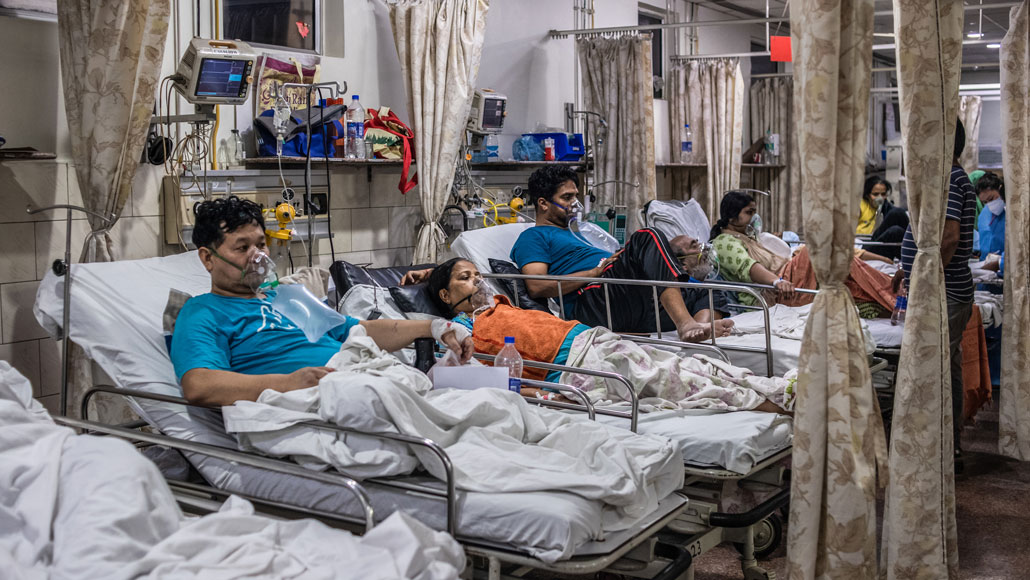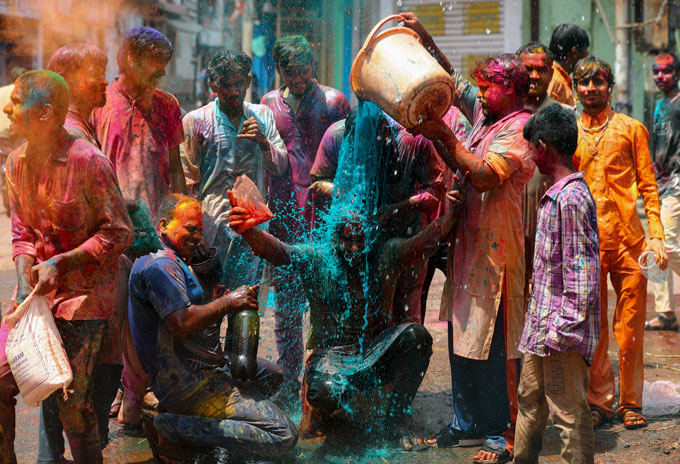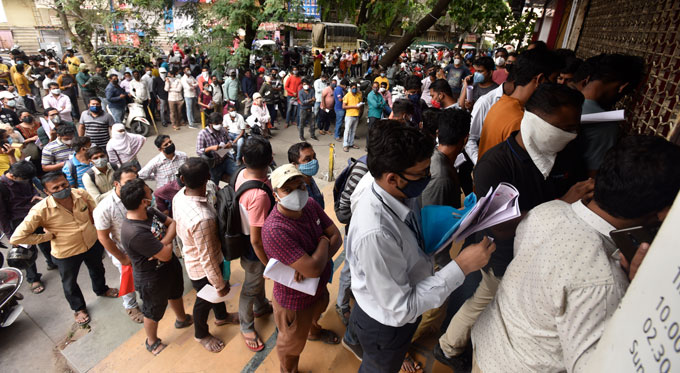How India’s COVID-19 crisis became the worst in the world
New variants and relaxed public health measures likely fueled the country’s surge

In the emergency ward of a hospital in New Delhi on May 3, patients relied on oxygen as they battled COVID-19. India’s health care system can’t keep up with the soaring case counts as the second wave of the coronavirus pandemic rages through the country.
Rebecca Conway/Getty Images
- More than 2 years ago
PUNE, India — Mohanish Ellitam watched helplessly as his 49-year-old mother’s oxygen levels dipped dangerously and she gasped for air. “I could see her stomach rising and falling,” Ellitam said. “I was so scared.”
Watching his mother’s health deteriorate, Ellitam knew he couldn’t wait any longer. But in Shevgaon, a small town in the state of Maharashtra, health care facilities were limited and already overwhelmed with people suffering from COVID-19. He frantically called friends, family and almost everyone on his contact list with connections to the region’s hospitals. After nearly 100 calls, on April 12 Ellitam finally found a spot at Surabhi Hospital in Ahmednagar, nearly 60 kilometers from his hometown.
But there was no room for relief just yet. His father, 53, also started growing tired and breathless. While his father stayed isolated in a hotel room opposite the hospital, Ellitam lived out of his car parked nearby, and the frustrating search for another hospital bed began.
“I was in a helpless state,” he said. “I felt alone. I broke into tears many times.”
This is what it’s like to be in the hardest-hit state in the country now hit hardest by the coronavirus pandemic. Although Ellitam’s father secured a bed in Surabhi Hospital a day later, scenes like this — and far worse — are playing out hundreds of thousands of times every day across India. As its second wave of COVID-19 sweeps through, India recorded more than 400,000 daily new cases on May 6 — the largest single-day spike in the world — and its highest daily death toll of 4,187, a day later. Those numbers are predicted to soar even higher in the coming days.
Dire SOS pleas from doctors, patients and their loved ones in need of hospital beds, oxygen and medication have flooded social media platforms. In Pune, one of the worst-hit cities in India, the wailing sirens of ambulances have become a macabre feature of the city’s soundscape. In many parts of the country, family members are shedding tears of despair outside of hospitals as they beg for medical attention for their dying kin.
“We don’t have enough ward beds, we don’t have enough ICU beds, and we’re running out of ventilators,” said Sumit Ray, a critical care specialist at Holy Family Hospital in India’s capital city of New Delhi. “People are coming into the ER requiring huge amounts of oxygen support, and we were on the edge of running out.”
Like many others in India, Ray is somewhat baffled by the seemingly sudden COVID-19 surge. In an unprecedented move, hundreds of scientists sent a plea on April 30 to Prime Minister Narendra Modi asking to ramp up data collection and allow access to already collected COVID-19 data. These scientists say more data are needed to understand how the coronavirus is spreading, manage the outbreak and predict what’s to come.
“It is essential now, more than ever before, that dynamic public health plans be implemented on the basis of scientific data to arrest the spread of infections and save the lives of our citizens,” they wrote. As of May 6, more than 800 scientists had signed on to that appeal.
How did we get here?
During the first wave of the pandemic in 2020, India reported over 90,000 daily new COVID-19 cases at its peak, with the highest single-day record at 97,894 on September 16. Daily case numbers then gradually declined to nearly 10,000 in early February.
The falling numbers ignited conversations about whether many Indians, especially those living in densely populated urban centers, might have already been exposed to the virus, thus conferring some immune defenses to prevent reinfection.
In Mumbai — home to more than 20 million people, more than 40 percent of whom live in overcrowded slums where disease can spread like wildfire — blood antibody tests of nearly 7,000 individuals from three municipal wards suggested 57 percent of the sample’s nearly 4,000 slum dwellers had a past infection with COVID-19, researchers reported in the Lancet Global Health in November 2020. In Delhi, similar tests showed that by January 2021, more than half of 28,000 people sampled in 272 municipal wards had developed antibodies against COVID-19 compared with 23 percent of 21,387 people sampled in early 2020.
A national serological survey of over 28,000 participants suggested that 1 in 4 Indians may have been exposed to COVID-19 by December 2020, researchers reported online March 4 on the preprint server SSRN.
“We thought we may not see a big second wave,” said Shahid Jameel, a virologist at Ashoka University in Sonipat, India. “Obviously we were wrong because we didn’t account for both the introductions and indigenous development of new variants.”
In December, India recorded its first six cases of the highly infectious B.1.1.7 variant, which was first identified in the United Kingdom. Between February and March, genetic testing showed that the variant became dominant in India’s northern state of Punjab, appearing in 326 of 401 sequenced viral samples. In New Delhi, B.1.1.7 was present in half the samples sequenced toward the end of March compared with 28 percent two weeks earlier.
India’s own B.1.617 variant first identified in October in Maharashtra is now present in up to 60 percent of samples from some parts of this hard-hit state, according to Jameel. This variant is also spreading in Delhi, he said, in addition to other parts of India and the world.
While B.1.1.7 is thought to be highly transmissible and potentially more lethal than other known variants (SN: 4/19/21), it’s still unclear how contagious B.1.617 is and if it induces severe disease. This makes it challenging to assess its role in India’s increasingly grim situation. One glimmer of hope is that Covaxin, a COVID-19 vaccine administered in India, appears to be effective against the variant, according to a recent paper posted online April 23 at the preprint server bioRxiv.org.
But just how much variants are driving the current surge remains poorly understood because scientists have sequenced viral genetic material from a mere 1 percent of all COVID-19 cases recorded from January to March 2021. “We cannot tell if variants are responsible because we’re not sequencing enough,” said Satyajit Rath, an immunologist associated with the Indian Institute of Science Education and Research in Pune and a signatory on the scientists’ appeal for access to data. “It’s not just inadequate but pathetic.”
A lax attitude toward mask wearing and social distancing in the aftermath of the stringent and prolonged national lockdown from March to June 2020 may also be a big factor in the surge. A misplaced sense of triumph over COVID-19 encouraged gatherings at weddings, political rallies and religious ceremonies. “All those became superspreader events,” Jameel said.
As people mingled and traveled, the virus likely spread and overwhelmed India’s unprepared health care system.

Struggles getting treatments
Many hospitals in the worst-hit parts of India house only severely ill COVID-19 patients. Some states have set up triage centers or “COVID-19 war rooms” to help prioritize patient care and hospitalization amid a grave shortage of resources.
At Mumbai’s P.D. Hinduja Hospital, pulmonologist Lancelot Pinto treats COVID-19 patients but also remotely manages moderately infected individuals, often entire families, who are quarantining at home. He’s seeing fevers that may last longer than a week (compared with just two or three days in the first wave), after which patients either recover or sometimes end up in the hospital due to complicating risk factors such as hypertension and diabetes.
In some cases, doctors are starting stay-at-home patients on steroids like dexamethasone and prednisone right away, in an effort to stave off more serious infections. But that can backfire. Although those drugs have been shown to reduce the risk of death of critically ill patients, they can actually dampen the immune response if given too early in an infection (SN: 9/2/20). That can make it harder for a patient to fight off the virus.
Some patients are also receiving a combination of as many as five to 10 other drugs, which can interact with each other and pose side effects. “We’ve been flabbergasted by the prescriptions we’ve seen throughout the last eight weeks,” Pinto said. “I’ve seen patients who’ve received such a cocktail of drugs deteriorate in their first week of getting admitted.”
Anxious and desperate patients are sometimes requesting — and doctors are sometimes prescribing — unproven treatments. Convalescent plasma therapy is one of them. Early in the pandemic, scientists thought blood plasma from recovered COVID-19 patients could help those newly infected get a jump-start on building up antibodies (SN: 8/25/20). But there’s little evidence the therapy can arrest progression to severe disease. And in India, some doctors are prescribing it as a last-resort measure, often under pressure from patient families who want to ensure they’ve tried everything they could. But several studies have failed to show that convalescent plasma reduces COVID-19 deaths at this late stage of infection.
Some doctors are also prescribing the antimalarial drug hydroxychloroquine. Despite scant evidence for the drug’s effectiveness (SN: 8/2/20), the Indian Council of Medical Research’s latest guidelines for managing COVID-19 still list hydroxychloroquine as a “may use” drug.
Even when a therapy shows some promise, it’s often not easy to get. In April, chaos erupted when the antiviral drug remdesivir, which can potentially shorten the COVID-19 recovery time by a few days but isn’t life-saving, became nearly unavailable (SN: 10/16/20). Some patients and their families resorted to purchasing the drug at two to five times the market price as a black market emerged amid the shortage. The hospital at which Ellitam’s parents were admitted, too, ran out of remdesivir. With help from friends in two different cities, each more than 100 kilometers away, he managed to procure four doses at market price.

Looking forward
An array of mathematical models predict that India’s surge will peak sometime between early and mid-May. Daily case numbers could rise to anywhere between 800,000 and 1 million, and single-day deaths may hit around 5,500 toward the end of the month, said Bhramar Mukherjee, a biostatistician at the University of Michigan in Ann Arbor who has been modeling India’s COVID-19 outbreak since March 2020. “That’s really troubling,” she said.
But these may be overestimates; Mukerjee’s model doesn’t account for the current lockdowns and restrictions that are in place in some states, cities and villages.
To quell case numbers, some public health experts in India say it’s time for a nationwide lockdown, but one that’s more coordinated and humane than the last lockdown. But the unfolding COVID-19 crisis is not just India’s problem; it’s the world’s problem. Rising numbers of infections can provide the virus with greater opportunities to mutate and evolve and thus form new variants (SN: 2/5/21). In a globally connected world, short of draconian lockdowns, it’s hard to contain the spread of infections and new strains. India’s outbreak has already spilled over into neighboring Nepal; other countries, including the United States, are now limiting travelers from India, but it may be too late. B.1.617 has already shown up in the United States and at least 20 other countries.
The crisis could also result in widespread vaccine shortages. India, the world’s largest producer of vaccines, has stopped exports to prioritize domestic needs. Even so, less than 2 percent of Indians are fully vaccinated and less than 9 percent have received their first shot, thanks to a major COVID-19 vaccine shortage. Ramping up vaccination efforts will be key to combating COVID-19, but it’s unlikely to pull India out of the current crisis.
Back in Shevgaon, Ellitam’s parents have recovered and returned home. But he is now battling the virus himself, lying in the same hospital where his parents spent nearly 10 days. Although he has a cough and is fatigued with moderate symptoms, he’s spending several hours every day making phone calls to help others find ventilator- and oxygen-supported hospital beds for their loved ones.
“The situation here is very bad,” he said. “I pray that no one ever goes through times like these.”
Sign up for our newsletter
We summarize the week's scientific breakthroughs every Thursday.







